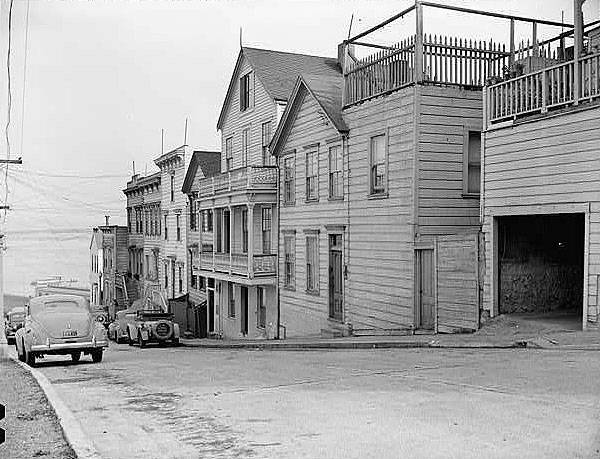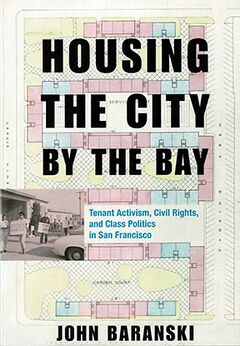San Francisco Housing Association
Historical Essay
by John Baranski
This excerpt originally appeared in "Progressive Era Housing Reform," Chapter One of Housing the City by the Bay: Tenant Activism, Civil Rights, and Class Politics in San Francisco (see below for copyright and book information)
Telegraph Hill, circa 1885, showing 230 Filbert (1858) and 228 Filbert (1869) on the Filbert Steps
Photo: San Francisco History Center, San Francisco Public Library, AAC-1358
In San Francisco, Alice Griffith used Telegraph Hill Neighborhood Association resources for a 1909 housing survey in the North Beach district. Under her direction, twenty-six students from a University of California, Berkeley, ethics class conducted a door-to-door survey. They recorded the size and number of rooms, the quantity and quality of water closets, and rents in every building, as well as the age, sex, ethnicity, and number of boarders living in the mostly Italian immigrant community. Photographs of the housing conditions complemented the data and text of these studies. San Francisco civic and religious groups conducted similar research in other parts of the city. The vivid reports confirmed what San Franciscans knew and saw: Since the 1906 disaster, the number of dark, unsanitary, overcrowded rooms had not only grown at an alarming rate but had spread “over every hill and into every valley of the city.”(17)
Aroused by this proof of the city’s deplorable housing and a sense of justice, representatives from civic and religious organizations—including the Council of Jewish Women, Women’s Public Health Association, Catholic Settlement and Humane Society, Commonwealth Club, and the Telegraph Hill Neighborhood Association—formed the San Francisco Housing Association on April 10, 1910. As in other cities in the United States, this voluntary organization aimed to improve the housing stock by strengthening the language and enforcement of local and state laws.(18)
Dr. Langley Porter, the San Francisco Housing Association’s first president, lamented that government’s failure to enforce housing legislation had “practically nullified the law.” The association also launched a public information campaign, complete with social surveys and exhibits, to persuade the public of the benefits of rational housing and planning. With their association, San Francisco’s housing reformers built a local housing reform community.(19) They joined a larger community of housing experts who belonged to the National Housing Association (NHA), a New York-based organization founded in 1909 with Russell Sage funding. Alice Griffith served as the city’s representative to the NHA, which brought international reformers together to develop solutions to the housing question while providing mutual support to members who saw few tangible victories.(20)
The San Francisco Housing Association influenced the shape and enforcement of government housing legislation. Working with Lester Burnett, a state senator from San Francisco, and the San Francisco Labor Council, the San Francisco Housing Association drew on Lawrence Veiller’s New York laws to draft legislation for California. Burnett successfully overcame California’s real estate interests by passing the 1911 Tenement House Act, which strengthened the state’s 1909 building, health, and maintenance codes. According to later surveys, the law helped reduce the number of crowded and poorly built and ventilated homes. In 1912, San Francisco created a planning commission, which enacted its first zoning laws in 1921.(21) In these ways, the new liberalism began to expand the regulatory role of government.
Yet, improvements in San Francisco housing conditions were slow. In a typical response to one of Griffith’s many letters complaining about a documented building violation in San Francisco, John P. Horgan, chief building inspector of the Department of Public Works, wrote: “As to the granting of permits in violation of the law, I assure you it is not, and never has been, the policy of this office; it is possible, however, that a slight error may occasionally occur.”(22) In 1913, San Francisco Housing Association President Langley Porter complained that the “state tenement house act was being perfunctorily enforced.” It was “impossible to enforce the State law without an adequate inspection force, yet even the modest request of the Board of Health for one or two inspectors has been refused by the Board of Supervisors.”(23) The lack of enforcement showed. When Griffith compared San Francisco housing surveys to New York, Boston, and Chicago surveys, the statistics gave “foundation to the belief that San Francisco conditions, unless checked, will, as the years pass, rival those of the large Eastern Cities.”(24)
By the eve of World War I, several reform traditions motivated the city’s housing activists. Certainly, the reformers wanted to improve the quality and safety of low-income housing and bring justice and government protections, however limited, to workers and their families. They believed that dark and crowded dwellings bred immorality, vice, and disease—at the individual, family, and neighborhood level. For some, they also wanted to use housing reform to spread Victorian ideas of gender roles and urban aesthetics to produce virtuous middle-class citizens and neighborhoods that looked like theirs.(25) These ideas firmly connected home, traditional gender roles, place, and values to the republic. Langley Porter put it this way:
Next to “mother,” “home” is the most sacred word in our language . . . to guard the home of the family has been an instinct of every right-minded human male. It has been the ambition of every far-seeing statesman to make his land a land filled with family ties, and his cities, cities of homes. From the foundation of the family rooted to its own home rises the permanence, the glory, and worth of this republic. Yet today rampant greed threatens this foundation.(26)
With San Francisco at the perceived edge of a closed frontier, the city’s reformers viewed healthy homes as a concrete way to reverse a decline of the nation’s political virtue while also advocating for economic justice.(27)
San Francisco reformers were motivated by a moral imperative to save the republic, improve housing, and bring about economic justice, but they also drew inspiration from a community of international reformers who promoted government housing and planning. Members of this group included community activists, intellectuals, architects, and planners: Lewis Mumford, Edith Wood, and Frederick Law Olmsted in the United States; Ebenezer Howard, Sidney Webb, and Raymond Unwin in Britain; and Albert Südekum and Hugo Lindemann in Germany. Their work focused on research and theory as much as on building codes, zoning laws, and urban planning. In the area of housing, they saw limited- dividend, cooperative, and public housing as ways to lower rents while at the same time improving the quality of working-class housing and neighborhoods.(28)
Alta Street south side, c. 1940.
Photo: Shaping San Francisco
In England, municipal governments influenced by Sidney Webb and other socialists built public housing (known as council housing) and planned communities (garden cities), while on the continent government housing programs emerged. In the United States, housing policies did not extend much beyond building codes and zoning laws, though a few labor unions and private organizations experimented with model tenements and cooperative housing. Whether in San Francisco, London, or Berlin, members of this housing and planning community thought government, not landlords and developers, held the keys to improved housing.(29)
previous article • continue reading
Notes
17. Quote in Telegraph Hill Neighborhood Association, Annual Report (1911). For low- income housing conditions, also see Telegraph Hill Neighborhood Association, Annual Report (1907); San Francisco Housing Association, Annual Reports (1911, 1912, and 1913); SFHA, 1939 Real Property Survey (1940). The social survey became a reform tool in an era marked by the dramatic social dislocations and conflicts of industrialization and urbanization. Mary and Charles Booth, W. E. B. Du Bois, and Jane Addams produced studies of London, Philadelphia, and Chicago. For studies of social surveys, see Mary O. Furner, “Knowing Capitalism: Public Investigation and the Labor Question in the Long Progressive Era,” in Mary O. Furner and Barry Supple, eds., The State and Economic Knowledge: The American and British Experience (New York: Cambridge University Press, 1990); Martin Bulmer, Kevin Bales, and Kathryn Kish Sklar, eds., The Social Survey in Historical Perspective, 1880–1940 (New York: Cambridge University Press, 1992); Mary O. Furner, “The Republican Tradition and the New Liberalism: Social Investigation, State Building, and Social Learning in the Gilded Age,” in Michael J. Lacey and Mary O. Furner, eds., The State and Social Investigation in Britain and the United States (New York and Cambridge: Cambridge University Press, 1993); Maurine W. Greenwald and Margo Anderson, eds., Pittsburgh Surveyed: Social Science and Social Reform in the Early Twentieth Century (Pittsburgh: University of Pittsburgh Press, 1996); Rodgers, Atlantic Crossings; Shelton Stromquist, Re-Inventing “The People”: The Progressive Movement, the Class Problem, and the Origins of Modern Liberalism (Champaign: University of Illinois Press, 2006).
18. San Francisco Housing Association, Annual Report (1911); John F. Bauman, Public Housing, Race, and Renewal: Urban Planning in Philadelphia, 1920–1974 (Philadelphia: Temple University Press, 1987); Robert B. Fairbanks, Making Better Citizens: Housing Reform and the Community Development Strategy in Cincinnati, 1890–1960 (Urbana: University of Illinois Press, 1988); Rodgers, Atlantic Crossings.
19. San Francisco Housing Association, Annual Reports (1911, 1912, and 1913). Porter quote in 1911 Annual Report, 7.
20. See NHA publications in Folder “Housing (1–3),” Box 76 “Housing,” John Randolph Haynes Papers Collection 1241, UCLA/DSC; San Francisco Housing Association, Annual Reports (1911, 1912, and 1913); Fairbanks, “From Better Dwellings to Better Neighborhoods.” Benedict Anderson’s concept of imagined communities is helpful for understanding how reformers, who often did not know one another personally, understood their collective identity and work, largely through printed materials. See his Imagined Communities: Reflections on the Origin and Spread of Nationalism (New York: Verso, 1996).
21. San Francisco Housing Association, Annual Reports (1911, 1912, and 1913); Telegraph Hill Neighborhood Association, Annual Report (1911); CCIH, First Annual Report (1915); Issel and Cherny, San Francisco; Ziegler-McPherson, Americanization in the States.
22. See Griffith’s correspondence in San Francisco Housing Association, Annual Report (1911).
23. San Francisco Housing Association, Annual Report (1913).
24. San Francisco Housing Association, Annual Reports (1911 and 1913); Telegraph Hill Neighborhood Association, Annual Report (1911); CCIH, First Annual Report, especially 10–12. Griffith quote in San Francisco Housing Association, Annual Report (1911).
25. San Francisco Housing Association, Annual Reports (1911, 1912, and 1913); Telegraph Hill Neighborhood Association, Annual Reports (1907 and 1911); Burton, Katherine Felton; Rogers, Atlantic Crossings; Ziegler-McPherson, Americanization in the States.
26. Quote on 6 in San Francisco Housing Association, Annual Report (1911).
27. The West’s social and urban problems, and the health of the republic in general, had “frontier thesis” overtones. See Frederick Jackson Turner, The Frontier in American History (Tucson: University of Arizona Press, 1997); Robert W. Rydell, All the World’s a Fair: Visions of Empire at American International Expositions, 1876–1916 (Chicago: University of Chicago Press, 1984); Brechin, Imperial San Francisco.
28. Catherine Bauer, Modern Housing (Boston: Houghton Mifflin, 1934); Gail Radford, Modern Housing for America: Policy Struggles in the New Deal Era (Chicago: University of Chicago Press, 1996); Marc A. Weiss, The Rise of the Community Builders: The American Real Estate Industry and Urban Land Planning (New York: Columbia University Press, 1987); Rodgers, Atlantic Crossings.
29. Ibid.
Excerpted from Housing the City by the Bay: Tenant Activism, Civil Rights, and Class Politics in San Francisco by John Baranski, published by Stanford University Press. Used by permission. © Copyright 2019 by John Baranski. All rights reserved.



